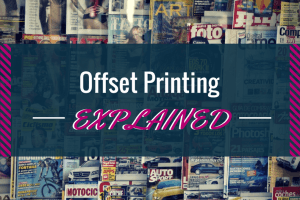Offset printing: what is it? What makes it better than digital printing? Read on to find out!
The process of offset lithography printing is one of the most common methods of producing printed materials, used both by web (in which a continuous sheet of paper is fed to the press and then cut into individual sheets of a desired size) and sheet-fed machines (where single sheets of paper are fed to the press one at a time). In a future blog, we will explain how this technology differs from that of digital printing presses.
For producing large volumes of high quality print, offset printing is typically the most cost-effective option. Magazines and catalogues are typically printed in this manner as well as the following other methods:-
- books
- brochures
- newspapers
The technical bit…..printing the ink onto the paper
In most modern offset printing plants, the pre-press studio utilises a computer-to-plate system that outputs the image of the artwork directly onto aluminium printing plates. Images are burned directly onto the specially treated plates using a laser.
Water-based and oil-based inks do not mix in offset lithography. According to this theory, the plate passes through ink and water rollers as it passes through the press. Ink from the ink rollers and water are drawn to the non-image area of the plate by the image area (design and words).
Afterwards, the outlined images on each plate are transferred to rubber cylinders (called blankets), which then transfer the images to paper. In offset lithography, there is no direct contact between the printing plate and the paper – hence, the name.
Rubber also extends the life of the plates and, what’s more, conforms readily to the print surface, so it can be used on non-smooth surfaces such as newsprint.
Colours
Typical print jobs are printed in CMYK: Cyan (blue), Magenta, Yellow and Black. Each of the four inks is placed in precise patterns that make it seem as if we are viewing a wide range of colours. As a result, offset printing is also referred to as four-colour printing or four-colour process printing.
The sheet-fed and web-fed equipment of some of our suppliers has additional printing units, allowing them to add special colours such as gold and silver or fluorescents for customers who require extra colour options. This is known as ‘spot colours’ and allows for a wide variety of colours that are not normally available.
As with traditional offset printing, each colour needs its own plate, and for web offset printing (or perfecting printing presses), each side of the paper needs its own plate, so that both sides of the sheet can be printed simultaneously.
The last stages….
With so much ink and water being applied, the paper is naturally slightly wet and is prone to smudging. In order to address this problem, the web presses pass the paper through a gas-fired oven that runs at 350 to 400 degrees Fahrenheit (or 176 to 206 degrees Celsius).
The difference here is that sheet-fed presses use oxidising inks so the paper is air-dried. This is because web-presses require a faster drying process since the paper is folded in section inline before binding. Sheet fed presses are folded off-line and can afford the additional drying time.
Advantages of Offset Printing
- Consistent Image Quality: Vibrant colours, clear typefaces, and fine detail.
- Variety of Print runs: This process is suitable for small, medium, and large-volume jobs.
- Economies of scale: Printing more reduces the price per unit. Setup costs account for most of the cost and extra quantities are charged a nominal fee per sheet for paper and ink.
Key points
- Imaged aluminium plates are used
- (cyan C yellow Y magenta M black K) is a typical printing process.
- This process is commonly used on both web and sheet-fed presses.
- There are some web offset machines as well as sheet-fed presses that can print either fifth or sixth colours.
- Printed on many grades of paper, from Newsprint up to triple coated gloss and most things in between.
- Sheet fed printing usually starts at 1000 copies, while web offset starts at 5000 copies.
- Printing can be done on paper as light as 39gsm or as heavy as 1000 microns, depending on the machine.
For free advice about your printing projects or to ask for a quote please email Simon@magazineprintingcompany.com or call us on 01323 419701

